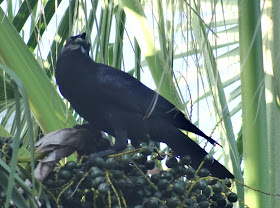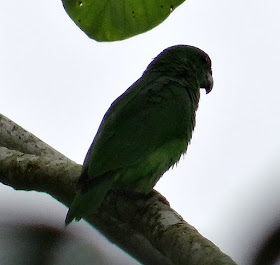 |
| Fernandina's Flicker |
Following our visit to La Belen (see following post) we headed north for a three-day stay on the tourist island of Cayo Coco where the tariff for our hotel, the Sol Cayo Coco - like all the upmarket accommodation here - includes as much food and alcohol as you care to consume. (Beware, the spirits are severely diluted.)
 |
| Cuban Gnatcatcher |
Early in the morning we headed east to the lighthouse on Cayo Paredon Grande. The mosquitoes were horrific but failed to prevent us from connecting with the specialties at this site in arid coastal scrub and mangroves. We found Cuban Gnatcatcher and Oriente Warbler in quick succession on a road near the lighthouse.
 |
| Thick-billed Vireo |
Soon after we had good views of a Thick-billed Vireo in the mangroves and we were to see a couple more as we strolled back along the main road in.
 |
| Cuban Green Woodpecker |
Cuban Oriole and Cuban Green Woodpecker were among the birds that showed which we had seen earlier and we saw Cuban Emerald and La Sagra’s Flycatcher again.
 |
| Cuban Oriole |
In the surrounding saline wetlands we found a flock of American Flamingoes.
 |
| American Flamingo |
Some waders were about including Greater Yellowleg, Semipalmated Plover and Grey Plover.
 |
| Greater Yellowlegs |
We saw several Cuban Black-Hawks close to the road.
 |
| Cuban Black-Hawk |
The next morning we headed east to Cape Guillermo, following directions provided by Andy Mitchell (see following post for Andy’s address). We found Bahama Mockingbird fairly easily in low coastal scrub – one bird singing close to the road and a couple of others moving about; they were much more skulky than the more numerous Northern Mockingbirds. We also found a flock of 4 Cuban (Zapata) Sparrows of the race that is endemic to these cays.
We looked unsuccessfully for Cuban Nightjar in the early hours of our last morning on Cayo Coco before heading west again to the Zapata Reserve for a 5-night stay at Playa Larga on the Bay of Pigs. Our delightful casa particular, Villo Rio Mar, overlooked this historic bay in an attractive setting.
We were off early in the morning with our guide, Angel Garcia (
angelczcuba@gmail.com) to explore Cuba’s premiere birding site and endeavour to clean up the country’s endemics and regional endemics.
 |
| Crescent-eyed Peewee |
Success came early in coastal scrub near the town of Soplillar with a wonderful pair of Fernandina’s Flickers displaying atop a dead tree; the birds flew in close for excellent views.
Next was a pair of Grey-fronted Quail-Doves on the road as we drove slowly along, followed shortly afterwards by 3 Blue-headed Quail-Doves; both endemic quail-doves can be difficult to find.
We reconnected with other birds we had seen elsewhere including Crescent-eyed Peewee, Cuban Emerald, Cuban Tody and Rose-throated Parrot.
 |
| Rose-throated Parrot |
 |
| Cuban Tody |
We then saw one of Cuba’s star attractions: the world’s smallest bird. A Bee Hummingbird perched atop a dead snag and we had great views of at least 3 of these tiny hummers, both perched and feeding. In the afternoon we visited a site near Soplillar that commemorates the anniversary of the 1959 Cuban revolution.
 |
| Bee Hummingbird |
 |
| Bee Hummingbird |
We left early on our second morning at Playa Larga for La Turba in the heart of the huge Zapata swamp. Before sunrise we enjoyed close views of a Cuban Nightjar on the road.
As the sun rose over the vast expanse of reeds, we connected with the Zapata Wren, which is endemic to this marshland. The wren can be easily missed but we enjoyed fantastic views of a bird singing at close quarters.
 |
| Zapata Wren |
We moved further into the swamp for equally close views of a pair of Cuban (Zapata) Sparrows – these birds of a different race to those we saw more distantly on Cayo Coco, and possibly a different species.
 |
| Cuban (Zapata) Sparrow |
On the road back we saw a pair of another of the region’s specialties – Red-shouldered Blackbird, along with more Cuban Blackbirds.
 |
| Cuban Blackbird |
Near Palipite we had close up views of the Cuban race of Northern Flicker, likely a different species.
In marshland nearby we had several waterbirds including Tricoloured Heron. In the afternoon we visited Cueva de los Pecas – a 70-metre deep sinkhole south of Playa Larga that connects to the ocean through an underground cave.
 |
| Tricoloured Heron |
The next morning we went with Angel early in the morning in search of owls around Playa Larga. We checked out 4 sites he had for Stygian Owl; we heard one quite close to our casa and finally had reasonable views of one in flight in a timber yard on the edge of town. Soon after we tracked down a family party of Bare-legged (Cuban Screech) Owls in roadside scrub; 2 adults and 1 or 2 juveniles were about and one of the birds showed nicely.
 |
| Bare-legged Owl |
Later in the day we visited Playa Giron and visited the museum commemorating the ill-fated 1961 Bay of Pigs invasion, when American-backed Cuban mercenaries were repelled by Fidel Castro’s forces. The United States to this day continues to impose its vindictive, cruel and contemptible embargo on this impoverished island nation.
 |
| Blue-headed Quail-Dove |
On the way back to Playa Larga we called in again on La Ceuva de los Pecas, where we saw 4 Blue-headed Quail-Doves close to the restaurant; the birds are fed by the staff and are very tame.
As we departed Playa Larga for a 3-day stay in Havana to complete our visit to Cuba, we called in at the village of Palpite where Bee Hummingbirds are known to congregate around a feeding tree. We saw several but the males were in eclipse plumage. Plenty of Cuban Emeralds were also about.
 |
| Cuban Emerald |
I ended my photographic exploration of Cuba’s avifauna by snapping what was probably the most numerous bird that we saw – Palm Warbler. Our trip was hugely successful, with all 39 targets seen (although Bill missed his West Indian Whistling-Duck) including all 26 "gettable" Cuban endemics.
 |
| Palm Warbler |
.
 |
| Grey-fronted Quail-Dove |


























































